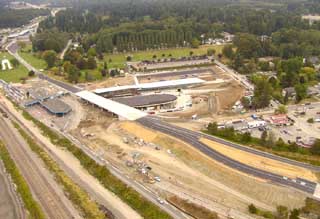
Magnusson Klemencic Associates
Specialty: Structural, civil, seismic and wind engineering
Management: Privately owned corporation by 10 hands-on engineers, including Chairman/CEO Jon Magnusson, President Ron Klemencic and COO Brian McIntyre
Founded: 1923
Headquarters: Seattle
2009 revenues: $26 million
Projected 2010 revenues: $25 million
Current projects: University of Washington Burke Museum expansion pre-design; Seattle Pacific University New University Center; Peace Arch U.S. Point of Entry, phase one, Blaine; Alaskan Way Viaduct Seawall Replacement Project building assessments; City Creek Center, Salt Lake City

Photo by Mike Derosa/Volvo Rents Magnusson Klemencic Associates performed structural and civil engineering for the reworked Peace Arch border crossing at Blaine.
|
Magnusson Klemencic Associates is a structural and civil engineering firm that has worked on a variety of projects, including WaMu Center, Benaroya Hall and the Central Library in Seattle, and an 87-story tower in Chicago and a 60-story building in Guangzhou, China.
Because of the poor economy MKA has cut staff by 30 percent in the last year, leaving it 111 employees, about what it had in 2004, said Jon Magnusson, the firm’s chairman and CEO. Additionally it has limited discretionary spending.
“It’s just that many of the markets that we had been very busy in just disappeared, for instance commercial office buildings — gone, the high-rise residential — gone,” he said.
More project leads
About mid-summer of this year, though, MKA began getting more leads for projects and clients starting talking about the “possibility of potential projects,” he said. Still, Magnusson said it will take time to absorb the office and residential inventory in most markets across the world.
“I actually believe that building construction is actually one of the biggest acts of faith and confidence in the future that anyone can take,” he said. “Until faith and confidence are restored it will be tough to get construction moving again.”
Smaller projects
Since the economy soured, MKA considers smaller projects than at the market’s peak, Magnusson said. For instance, “for a residential project it was at a point where if it was much under 40 stories we really couldn’t touch it,” he said, “and now we would consider any height.”
As during the peak, contractors are looking for easy-to-build designs and low construction costs, and other clients want MKA to focus on making structures look good and supporting the architect’s aesthetic goals, Magnusson said.
“We’ve been successful on both fronts,” he said.
Medical buildings are among the projects MKA is doing. However, proposed national health care reform has created uncertainty about how much health care providers will be reimbursed for services, so some are holding back on building, Magnusson said.
Professional and collegiate sports complex development is still moving forward — “it’s not frozen-up like some other markets,” he said, and MKA is working on a number of sports facilities. For instance, it is on a team that would construct a new San Francisco 49ers football stadium, currently planned for Santa Clara, Calif., Magnusson said.
“That is imminent,” he said.
Design-build
The firm also is on teams for a number of public projects. Many of those project types have been going design-build, where design and construction aspects of a development are contracted for with a single entity, Magnusson said. So now, for MKA to win bids it must align itself with firms that address more aspects of a development than just design and engineering, he said.
For example, he said, the state of California is looking to design-build a courthouse in Long Beach, an approximately $300 million development. It is seeking proposals from teams which will involve the developer, who would build the complex and then lease it back to the state.
So not only will the state look at design and construction, it will consider the “financial factor” of how much rent the developer will charge, Magnusson said.
“It’s just a much higher bar in terms of the amount of work you have to do just to get to the point where you are selected for the work,” he said.
Magnusson estimates that his firm is in competition for more than a billion dollars in design-build construction projects.
Advocates say design-build saves time and money, he said.
“My personal opinion is it does a better job of creating certainty and transferring risk from an owner to a design-build team,” he said. “Whether it truly saves time and money depends on a lot of different factors.”